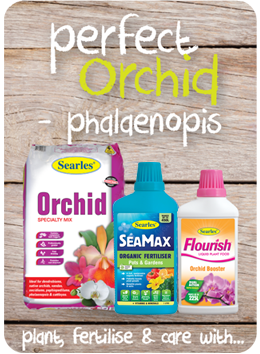|
Phalaenopsis are also called the “moth orchid”, as their flowers resemble the shape of a moth or butterfly. These are one of the very easiest orchids to grow, and often bloom for over 3 months!
TEMPERATURE
Phalaenopsis enjoy much the same temperature range as we do. The minimum temperature at night is 15°C, while the average daytime temperature should be around 25°C. Occasional deviations will not harm your plant, except when it is in bud — chilly temperatures may cause the plant to stop budding.
LIGHT
Phalaenopsis will flourish indoors under normal lighting conditions, with indirect sunlight being the most advantageous. Caution should be used when placing a Phalaenopsis in direct sunlight due to the fact that its leaves burn easily from too much exposure to the sun.
WATERING
Water often enough to keep continuous moisture just below the surface of the medium, but be cautious of over-watering. Watering once a week is normally sufficient to keep your plant healthy and happy.
FEEDING
For the best results, fertilize with Searles Flourish Orchid Booster. Apply every 7 to 14 days over foliage and soil. To stimulate plant resistance to insect and disease attack, apply SeaMax Organic Fertiliser every 2 to 4 weeks.
HUMIDITY
Phalaenopsis enjoy moist air, with a humidity level of 55-75% being ideal. Placing your plant over a tray or dish of water can increase moisture. Separate the pot and tray with pebbles or small stones to raise the height of your plant and ensure that it does not sit directly in the water.
REPOTTING
Plants should be re potted every other year and, because they grow upwards without spreading, can go back into the same sized pot. Re pot with a specially designed orchid mix for phalaenopsis like Searles Orchid Mix. Water sparingly until new roots are well established.
For brilliant results with your Phalaenopsis:
- Repot with Searles Orchid Mix for Phalaenopsis.
- Feed with Searles Flourish Orchid Booster and SeaMax Organic Fertiliser.
Note: When the last flower drops, cut your flower spike halfway down the stem. Continue caring for it and wait for re-bloom.
|






